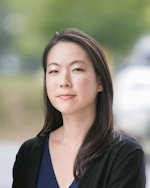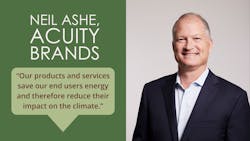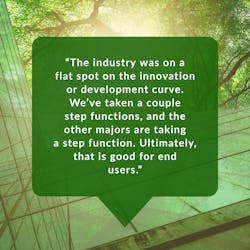LAST WORD | Acuity reveals ESG efforts can improve a company’s bottom line
Last November, Acuity Brands released its fourth annual EarthLight Report, sharing its environmental, social, and governance (ESG) accomplishments, new ESG targets, and ongoing initiatives. In January, shortly after the company’s first-quarter earnings call, CEO Neil Ashe spoke with LEDs Magazine to offer more details on the company’s progress.
LEDs: How do you plan to continue reducing Acuity Brands’ carbon emissions and Scope 3 emissions (indirect emissions from a company’s value chain) in particular?
Ashe: We have focused on two mega trends: minimizing the impact of climate change and maximizing the impact of technology. We’ve positioned the company at the intersection of sustainability and technology. Our products and services save our end users energy and therefore reduce their impact on the climate. The first step was our own operations. We became carbon neutral mostly through our actions with a little bit of offset. Next, we committed to net zero by 2040. We are working with the Science Based Targets initiative (SBTi).
In the interim, we committed to mitigating the impact of 100 million metric tons of carbon for our put-in-place products and services between 2020 and 2030. As we look forward with SBTi, we need to figure out how we get there for Scope 3. One, each of our products and services that we design will improve energy usage and therefore climate impact — that’s a standard part of our design process at this point. Number two, everyone who makes this commitment is assuming that the grid will improve over this period of time to get us there. So we are confident in controlling the things that we can control, and we are joining with the rest of the world on betting on grid improvements.
LEDs: In your earnings call, you said Acuity is rolling out recyclable and more compact products, which will reduce transportation costs and environmental impact. Do you plan to continue launching more such products?
Ashe: This is a great window into how we are doing things. We take the A-Light brand, a smaller architectural driven brand, where we can innovate more rapidly, take what we learn and incorporate that into the rest of our product portfolio. We now have the opportunity to scale to a large implementation with one of our large customers and continue to scale through the rest of the portfolio to have a greater impact.
LEDs: Acuity Brands recorded $4 billion in sales in 2022. How did that compare to expectations? How much of that revenue came from recently acquired brands?
Ashe: Obviously, we think our revenue growth was earned based on our performance. Let me break that down. We’ve been consistent about our strategy of investing in product vitality so that our products are the highest value available in the marketplace; and investing in service so that our customers and end users can count on us to deliver products where and when they need them.
That’s been the overriding driver of growth over the last several years. But the real power here is the relationship between product vitality and service. We have cutting-edge products in the marketplace, which are taking share because they deserve to take share; and our service model combined with North American manufacturing and selective sourcing of finished goods from Asia allows us to serve customer needs.
We haven’t made that many acquisitions. We acquired ams Osram’s North American Digital Systems business, which involved several Osram brands including OPTOTRONIC drivers, PrevaLED LED modules, and QUICKTRONIC ballast products. OPTOTRONIC and PrevaLED were both folded up under eldoLED. That’s gone well, but it’s small compared to the larger enterprise. The brands that we’ve acquired in the 2019–2020 timeframe have continued to grow.
LEDs: Has the pandemic proven your strategy?
Ashe: I started here a month before the pandemic started; the strategy was put in place before then. As we entered the pandemic, we said we were going to one, take care of our people, and two, we were going to emerge from this as a better company. That pushed us to change things we didn’t think we could change. Take, for example, our manufacturing facilities in Mexico. We reinvented the people flows and the manufacturing processes there probably five to eight times over that two-year period. We had taken a lot of things for granted, and we had to reinvent and reimagine.
That has allowed us to manufacture more things more efficiently. It also gave us an opportunity to demonstrate to the industry what we were capable of doing.
LEDs: What are some of your favorite accomplishments from the 2022 EarthLight report?
Ashe: I’m proud that we have purposely transitioned the company to be a values-driven organization. We want to be the place where the best people come to do their best work. That drives our strategy around people. We have no bias on where you came from, what you look like, who you love, who you worship. None of that matters to us.
We want to make an impact on the communities in which we participate, but we also do that for our people. If we build an environment where people can do their best, then we can raise our expectations for what we are capable of doing. This is a virtuous cycle that makes us a better company and increases our growth prospects going forward.
LEDs: Do you find balancing between the indifference to employee backgrounds and beliefs and encouraging employees to bring their whole selves to work challenging?
Ashe: No, because we are creating an environment where what’s expected and rewarded is the contribution. And everyone has the opportunity to make that contribution. We all are aligned to be going in the same direction. The people that are here are opting in because they want to be on the journey we’re traveling together. A lot of our strategies around people, talent development, and organizational development are there to help people realize their best selves.
If you went to a product development meeting, you’d look around and see people of color, multiple genders. But I humbly believe we’re past that conversation. Instead, the conversation is “Can this luminaire deliver a better outcome for our end user because it uses less energy, emits less carbon, and allows the end user to do something they didn’t know they were capable of?”
LEDs: What leadership development opportunities does Acuity offer?
Ashe: As part of our people strategy, we have long-term development plans and short-term talent assessment for our key folks and candidates for leadership, and that’s cascading throughout the organization. The talent efforts goes all the way to assembly operators and ourselves. That’s where we’re investing in the individual, and we’re giving the individual the opportunity to invest in themselves. This prepares everyone for the opportunity for leadership, and then it becomes a discussion of who can lead us best.
Even if a person ends up leaving Acuity, you’re going to leave more capable than you were when you got here. To me, that is a win for you, the associate [what Acuity calls its employees], and for us, the company.
LEDs: How can you offer development plans for everyone at such a large company?
Ashe: We have 13,000 to 14,000 associates. It’s a repeatable process, but it goes broader and deeper in certain parts of the organization. But everyone here has the opportunity to have an honest evaluation of their current performance and an honest discussion about where they can go in the company.
LEDs: Can you share more on Acuity’s DEI commitments and initiatives?
Ashe: We develop everyone, and we meet them where they are for that development. Our workforce is approaching half female and a large percentage of people of color. We have work to do on [achieving representation in] leadership proportional to population [demographics]. But we are in relatively good shape, and we do an active listening strategy where we survey all of our associates every year. Our engagement scores show higher than [those in] manufacturing or technology, and they give us a roadmap for where development is. We’ve identified what we think can help close gaps that need to be closed.
LEDs: The EarthLight report says a pay equity survey was conducted in 2022 and that the company is addressing findings from that survey. Can you elaborate on the survey findings?
Ashe: The survey was a subset of our annual conversation with our associates. We do it every year, so we didn’t have an “oh my gosh” moment there. The survey is driven by two things: One is an evaluation of where we are versus the rest of the market. Two, from a total rewards perspective, not everyone wants the same things, so it’s important to understand what are drivers for our associate population so that we can meet them where they want to be. No company can afford to give everyone everything that they want. What we’ve done as a result of that survey is a significant amount of work on making sure our opportunities — our jobs — are effectively compared to the rest of the market. Second, we’ve made sure that inside of our company, there’s equity — there’s internal equity based on what your role is and it’s tied to the outside market. Third, we’ve evaluated what total rewards opportunities we can provide now and in the future that satisfy the needs of the largest portion of our population.
LEDs: How do you view the continuing consolidation of the lighting industry, and the merging and acquisition of smaller brands into bigger companies? Does that benefit the industry and end users?
Ashe: I’ll focus on us first. There’s two ways to consolidate: You can buy or you can grow your share — and we’ve done both. The Osram DS acquisition allows us to control more of the technology that’s in our luminaires to participate more wholesomely as an OEM supplier and to take greater control of our electronic supply chains. That consolidation has been valuable for our end users because we could serve them more effectively in challenging times through and post the pandemic. And it allows us to innovate faster.
It’s also valuable that other larger companies have consolidated so they can start to focus on their R&D efforts. What is happening as a result is that the [major companies] are increasing their product quality, which is better for end users. The industry was on a flat spot on the innovation or development curve. We’ve taken a couple step functions, and the other majors are taking a step function. Ultimately, that is good for end users.
LEDs: What lessons have your learned during your tenure at Acuity, and how do you plan to apply those moving forward?
Ashe: I’ve spent my career helping companies change in a rapidly changing environment. A lot of people [have asked after the pandemic], “When can we return to normal?” There’s no such thing as “return.” Change is going to continue to happen. Acuity has become really good at adapting to whatever the future holds, and we’ve built the ability to change quickly inside of our organization. That’s the muscle we have developed. We’ll only get better at that with more practice.
LEDs: When you say that Acuity can adapt quickly, are there certain channels or levers that you can deploy quickly?
Ashe: I don’t want to go into a ton of detail, but through our better, smarter, faster operating system, we can as an organization move with more velocity, which means pace and direction. And so we can change more effectively because the whole organization is aligned on how to do that.
That’s how we can react to big things like a pandemic or a recession.
LEDs: Can you give a specific example of how the company could react quickly?
Ashe: Let’s take our manufacturing facilities. Through the pandemic, we reinvented how we actually make things and how people flow through the facilities multiple times. When you do that, you quickly realize, “Wow, we’re really good at this. We can change.” Another example is that we’ve changed our cycle time of how we develop products so that we deliver more value faster. A third is that we built the people infrastructure I described earlier — the evaluation and talent development plans — and all those things come together and compound on each other.
LEDs: Are you concerned about a global recession, or is Acuity ready for whatever comes?
Ashe: We can’t control whether we’re going to go into a recession, so no sense wasting calories worrying about that. We spend our calories worrying about whether we are good at changing because we want to do that, whether we go into a recession or not. I’d rather us not go into a recession for lots of reasons, but we are prepared if we do.
This interview has been condensed and edited for clarity.
WANDA LAU is editorial director of LEDs Magazine, Architectural SSL, and Smart Buildings Technology. She previously served as executive editor of Architect magazine and worked for a decade in the architecture, engineering, and construction industry.
For up-to-the-minute LED and SSL updates, follow us on Twitter. You’ll find curated content and commentary, as well as information on industry events, webcasts, and surveys on our LinkedIn page and our Facebook page.

Wanda Lau | Editorial director, LEDs Magazine, Architectural SSL, and Smart Buildings Technology
Wanda Lau is an award-winning editor, writer, and podcaster whose work appears in several publications, including Architectural Lighting and Architect, where she was most recently the executive editor. In 2021, she was named one of Folio: and AdMonsters' Top Women in Media, in the DEI Champions category. Along with working a decade in the architecture, engineering, and construction industry, she holds a B.S. in civil engineering from Michigan State University, an S.M. in building technology from MIT, and an M.A. in journalism from Syracuse University.







